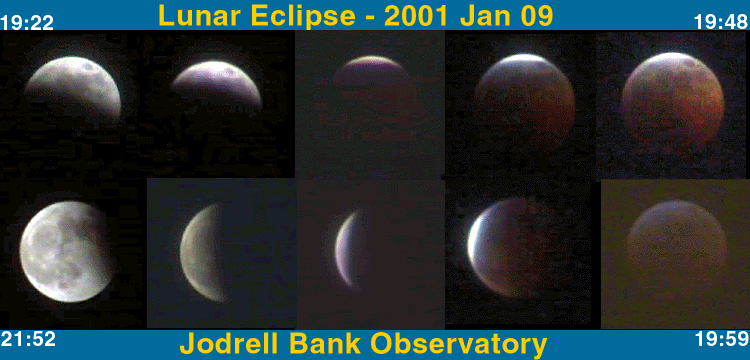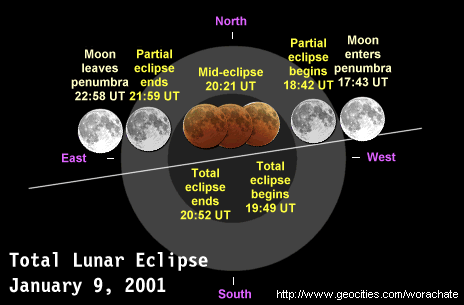A Total Eclipse of the Moon in the evening of January 9th 2001
Updated 10/1/2001 - Movie and Images of the Eclipse
8 January 2001
Download an MPEG movie of the lunar eclipse (160x120 pixels 250KB) or (320x240 pixels 2MB)
This mpeg movie was created from a sequence of webcam images. The movie runs from 2001 Jan 09 18:52 to 22:04. At the beginning of the movie you see the Moon at bottom left - note the image is overexposed, the Moon itself would appear as a very small disk in a field of view of around 45 degrees. At top right you can see Jupiter. The viewing direction is fixed so that as time goes on the Moon (and Jupiter) move diagonally from bottom left to top right as the Earth rotates. You see the brightness of the Moon fade as it enters eclipse and then recover as it leaves the Earth's shadow.

The top row of this montage of still images shows the changing appearance of the Moon as it heads towards totality from about 19:22 at top left across to 19:48 at top right. The sequence then moves along the bottom row from 19:59 (in total eclipse) at right to 21:52 at left when the Moon has almost left the Earth's umbral shadow. This movie and montage were created by Anthony Holloway and Tim O'Brien.
Should the sky be clear during the evening of Tuesday 9th January we will be able to observe what is expected to be one of the most beautiful Lunar eclipses for many years. From 6:42 pm the dark shadow of the Earth will begin to encroach on the disc of the full moon hanging in the eastern sky. Just over an hour later at 7:49 pm, the whole surface will be covered and the Moon's colour will become a deep coppery red as it is then only illuminated by light scattered and filtered by the Earth's atmosphere. The total eclipse will last for 62 minutes until 8:52 pm when the Sun's direct light begins to fall on the surface again. The Earth's shadow will finally move away from the Moon at 9:59 pm.

A diagram of the Eclipse circumstances
During totality the light we see reflected from the surface of the Moon has had to pass through the Earth's atmosphere which scatters out the blue light so that the light reaching the Moon is predominantly red in colour in just the same way as the setting Sun appears red. The amount of light passing through the atmosphere depends on the amount of dust in the Earth's upper atmosphere and this, in turn, is affected by recent volcanic activity on Earth. Following a major eruption so much light can be absorbed in the atmosphere that the Moon is barely visible, but the last really big volcanic eruption, that of Mount Pinatubo in the Philippines, was almost a decade ago and so the upper air should be more transparent than usual allowing us to see the brightest and most colourful Lunar Eclipse for many years.
For further information contact:
Ian Morison, im@jb.man.ac.uk
01477 572610 (direct)
01477 571321 (Jodrell Bank switchboard - home number can be got from there)


